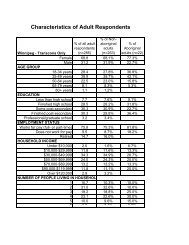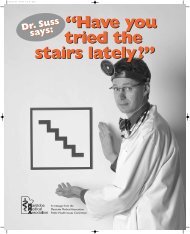Wave: March / April 2010 - Winnipeg in motion
Wave: March / April 2010 - Winnipeg in motion
Wave: March / April 2010 - Winnipeg in motion
Create successful ePaper yourself
Turn your PDF publications into a flip-book with our unique Google optimized e-Paper software.
the eight-year age gap, he and Jeff have<br />
not been as close as other brothers, but<br />
through this process, they are beg<strong>in</strong>n<strong>in</strong>g to<br />
joke around a bit more.<br />
David’s cool demeanour belies the<br />
remarkably selfless act he is about to perform.<br />
Jeff, as a recipient, expresses deeper,<br />
more personal sentiments.<br />
He believes it is “the deepest act of<br />
love.” He suggests there should be a ritual<br />
attached to the process – perhaps an exchange<br />
of letters between brothers. As time<br />
passes, however, he realizes that while<br />
there will now be a deeper connection<br />
with his brother, e<strong>motion</strong>s will not be expressed<br />
openly. That’s just not David’s style.<br />
Meet<strong>in</strong>g the surgeon<br />
By the first week of November 2009, Jeff<br />
and David are beg<strong>in</strong>n<strong>in</strong>g to tick off their<br />
pre-surgery appo<strong>in</strong>tments. Today, they are<br />
meet<strong>in</strong>g Dr. Josh Koulack, the surgeon who<br />
performs most of the kidney transplants <strong>in</strong><br />
the prov<strong>in</strong>ce.<br />
As arranged, Jeff and David meet at the<br />
yellow desk on the ma<strong>in</strong> floor of Health<br />
Sciences Centre, their attire as much a<br />
study <strong>in</strong> contrasts as their personalities.<br />
David is the more formal of the two,<br />
wear<strong>in</strong>g a black shirt, jacket and trousers.<br />
Jeff, meanwhile, is wear<strong>in</strong>g a green T-Shirt<br />
under a black fleece jacket. A nurse leads<br />
them to a small, bright cl<strong>in</strong>ic room where<br />
they await the surgeon.<br />
The meet<strong>in</strong>g with Koulack is brief, consider<strong>in</strong>g<br />
the importance of the procedure.<br />
After review<strong>in</strong>g medical histories, Koulack<br />
first expla<strong>in</strong>s how he will remove the kidney,<br />
artery, ve<strong>in</strong> and ureter from David’s left<br />
side. Because of a stent implanted <strong>in</strong> Jeff’s<br />
left leg, he will place the new organ on the<br />
right side of Jeff’s abdomen.<br />
The tricky part is attach<strong>in</strong>g the ureter to<br />
the recipient’s bladder: “We have to go<br />
through a muscle and because that can<br />
cause a clot, to be preventive, we put <strong>in</strong> a<br />
stent – like a little tunnel – from the new<br />
kidney to the bladder,” expla<strong>in</strong>s Koulack.<br />
“Six weeks later, we remove the stent.”<br />
Surpris<strong>in</strong>gly, as they sign the consent<br />
forms, David and Jeff have few questions.<br />
Later, walk<strong>in</strong>g out, David remarks dryly<br />
on Koulack’s youthful appearance. “Do<br />
you th<strong>in</strong>k he is really old enough to do the<br />
surgery?” Jok<strong>in</strong>g aside, both men have full<br />
confidence <strong>in</strong> this surgeon. After all, he<br />
does up to 40 transplants a year. And, truth<br />
be told, at this stage the brothers just want<br />
to get on with it. (David’s sense of humour<br />
never disappears: A few days later, dur<strong>in</strong>g<br />
the day-long pre-admissions cl<strong>in</strong>ic, he<br />
remarks: “You know, ever s<strong>in</strong>ce I saw Dr.<br />
Koulack, my left kidney has been hurt<strong>in</strong>g.”)<br />
It’s show time<br />
On Wednesday, Nov. 25, 2009, Jeff<br />
Sk<strong>in</strong>ner, his dialysis equipment loaded<br />
<strong>in</strong>to a wheelchair, checks <strong>in</strong>to the Health<br />
Sciences Centre and enters a room on ward<br />
GD-4, which he will share with his brother.<br />
Dr. David Rush, a nephrologist and Medical<br />
Director of Transplant Manitoba, Adult<br />
Kidney Program, greets him warmly. “Soon<br />
you’ll be <strong>in</strong> a pretty blue gown – and then<br />
I will check you over,” says Rush. “And as<br />
luck would have it, I’m on call and will be<br />
your doctor this weekend,” he adds.<br />
The next day, on Nov. 26, David is<br />
admitted early <strong>in</strong> the morn<strong>in</strong>g, a couple of<br />
hours before surgery.<br />
By all accounts, surgery on both donor<br />
and recipient went well. David had a<br />
remarkable recovery. He was up and about<br />
two days later and discharged on the third.<br />
Jeff, however, had a serious setback.<br />
On the Saturday night follow<strong>in</strong>g surgery,<br />
at 11 p.m., the new kidney shut down.<br />
Under the direction of Rush – who came<br />
<strong>in</strong> at 5 a.m. Sunday – Jeff was put through<br />
a barrage of tests and procedures, from irrigation<br />
to ultrasound to CT scans. There was<br />
even talk of remov<strong>in</strong>g the kidney. No one<br />
knew what had happened. Then – just as<br />
mysteriously – at 1 p.m. Sunday, the kidney<br />
started to flow by itself. A week later, he<br />
was allowed to go home.<br />
Back to work<br />
Today, almost four months after surgery,<br />
David is do<strong>in</strong>g well. He’s back at work,<br />
revitalized from that long-awaited w<strong>in</strong>ter<br />
vacation. Jeff is also do<strong>in</strong>g well, as evidenced<br />
by his desire to br<strong>in</strong>g the best out<br />
of his students on this January even<strong>in</strong>g.<br />
But even as his charges run through their<br />
scripts one more time, Jeff knows his own<br />
story is not yet complete. He’s still be<strong>in</strong>g<br />
monitored twice a week at the transplant<br />
cl<strong>in</strong>ic, and he’s still adjust<strong>in</strong>g to the daily<br />
regimen of anti-rejection drugs that he will<br />
take every 12 hours for the rest of his life.<br />
Tak<strong>in</strong>g a moment to reflect on his<br />
journey, Jeff wastes few words on himself.<br />
Instead, he lavishes praise on the “phenomenal”<br />
medical team of doctors, nurses, and<br />
unit assistants that cared for him dur<strong>in</strong>g his<br />
13-day hospital stay. “I was trapped <strong>in</strong> my<br />
bed; I was at their mercy; yet they made me<br />
feel empowered,” he says. “They allowed<br />
me a sense of control. I felt as though we<br />
were work<strong>in</strong>g together to get me better.”<br />
His praise extends to his present care<br />
at the transplant cl<strong>in</strong>ic where already everyone<br />
knows him by name. “It’s all about<br />
help<strong>in</strong>g me manage with respect and dignity,”<br />
he says. “This is, after all, a lifelong<br />
relationship.”<br />
Dolores Haggarty is a <strong>W<strong>in</strong>nipeg</strong> writer.<br />
About Transplant Manitoba<br />
Kidney transplantation has been<br />
performed <strong>in</strong> Manitoba s<strong>in</strong>ce 1969.<br />
To date, 1,282 transplants have been<br />
done, and there are currently more<br />
than 500 adult patients with a kidney<br />
transplant followed as outpatients <strong>in</strong><br />
the program.<br />
The number of kidney transplants<br />
done annually <strong>in</strong> Manitoba varies. In<br />
1998, for example, 26 transplants were<br />
performed, the lowest number <strong>in</strong> the<br />
last 12 years.<br />
In 2004 and 2005, only 28 and 30<br />
kidney transplants were performed,<br />
respectively.<br />
The <strong>W<strong>in</strong>nipeg</strong> Health Region <strong>in</strong>creased<br />
support for the program <strong>in</strong> 2005, which<br />
resulted <strong>in</strong> 48 renal transplants be<strong>in</strong>g<br />
performed <strong>in</strong> 2006 and a high of 52<br />
transplants done <strong>in</strong> 2007.<br />
In 2009, Transplant Manitoba performed<br />
46 kidney transplants, with 20<br />
kidneys derived from live donors and<br />
26 from deceased donors. Currently,<br />
there are about 170 Manitobans wait<strong>in</strong>g<br />
for a kidney transplant.<br />
You can help someone <strong>in</strong> need<br />
of an organ transplant by sign<strong>in</strong>g an<br />
organ donation card and<br />
confirm<strong>in</strong>g your <strong>in</strong>tentions with<br />
family members and loved ones.<br />
For more <strong>in</strong>formation, please visit<br />
www.transplantmanitoba.ca.<br />
24 WAVE













